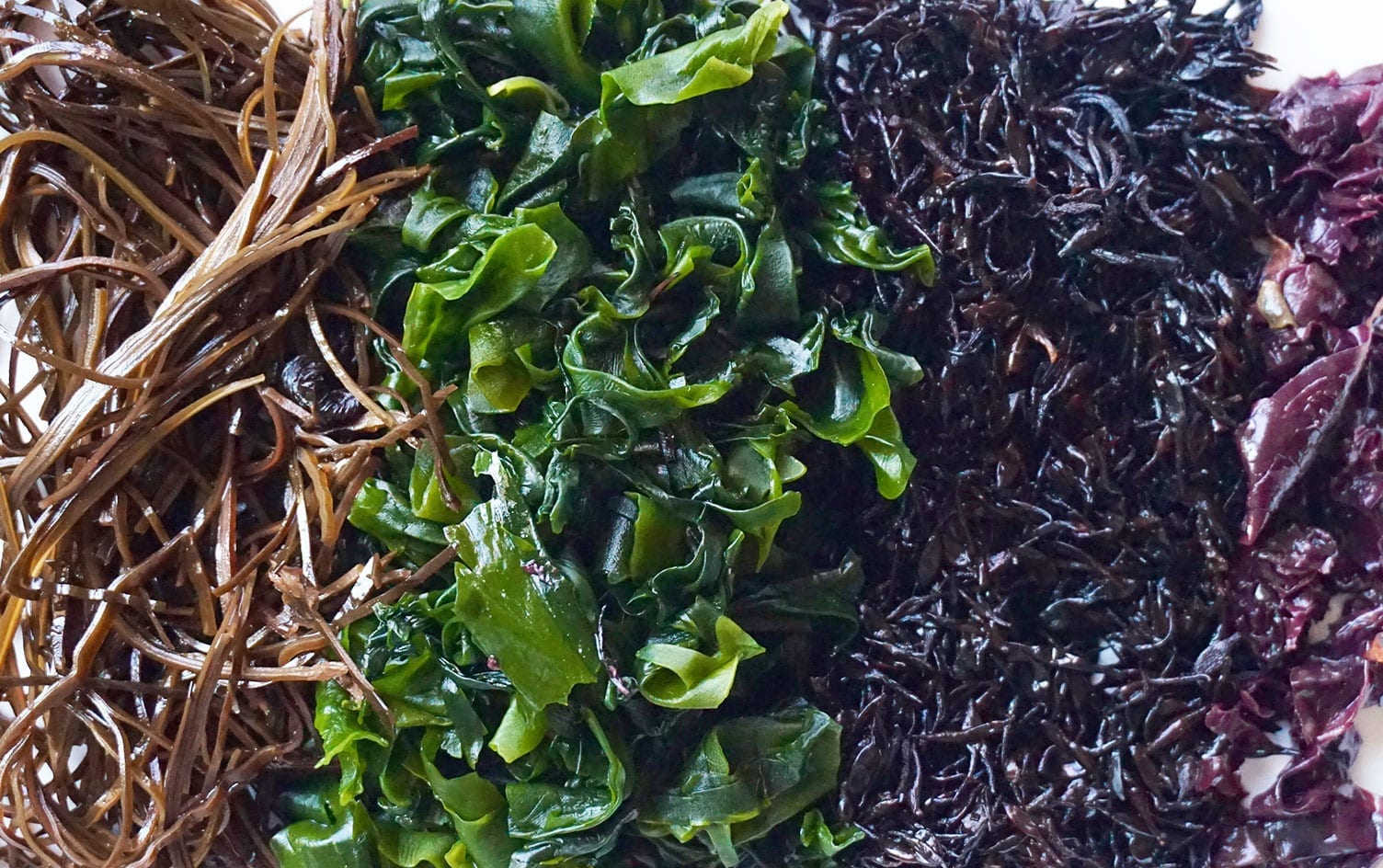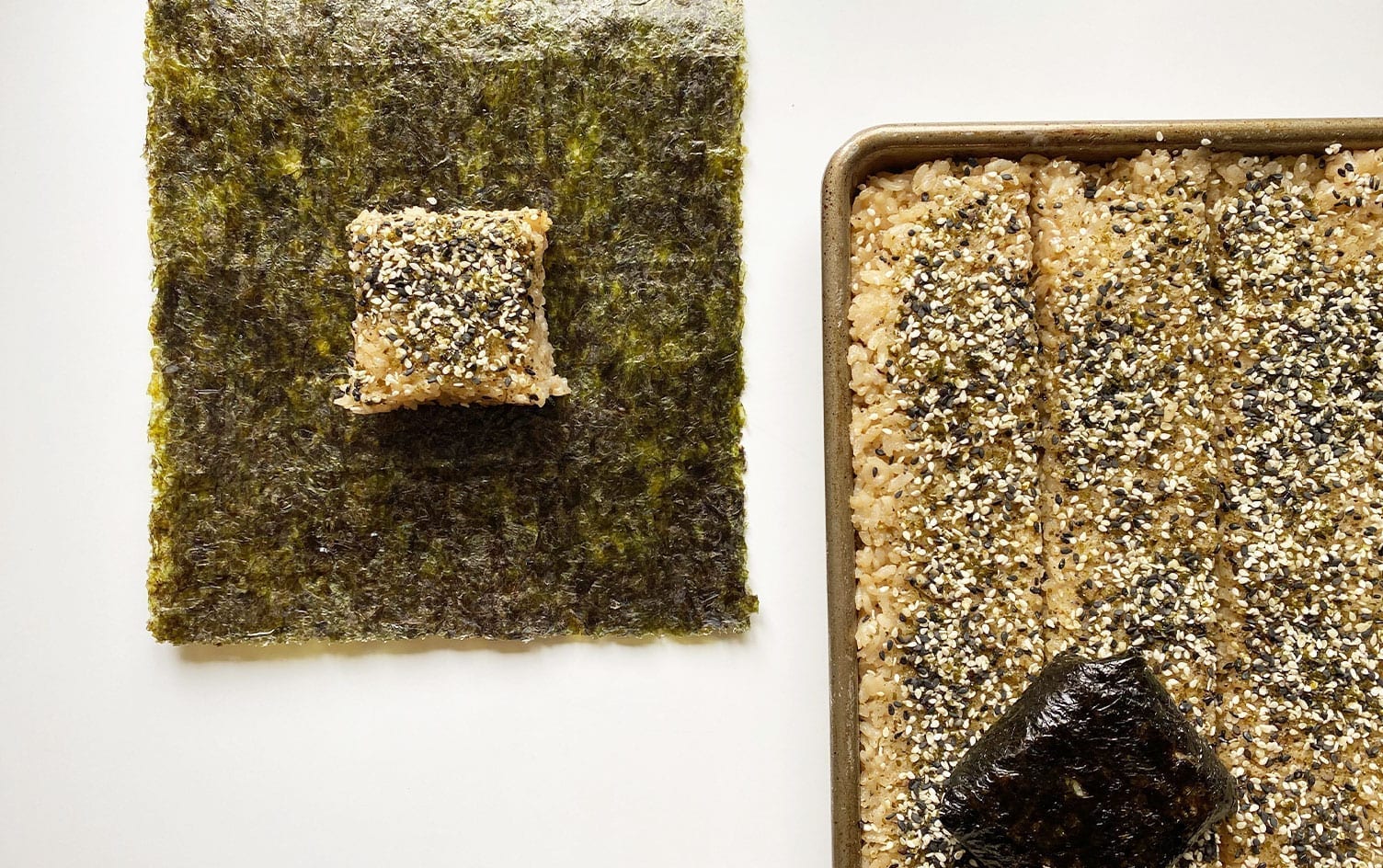“Eat your vegetables,” says that little voice inside your head. But if you ever want to go beyond eating your usual veggie suspects, mix it up and look to the sea. Sea vegetables, specifically seaweed, are the most often overlooked seafood, and one of the most nutritionally dense.
Seaweed — a term used to describe many different marine-based species of plants and algae — is the most plentiful known natural source of iodine, which helps support your thyroid gland and hormone balance. Seaweeds are also rich in vitamins and minerals such as vitamin K, B, zinc and iron as well as antioxidants that protect against cellular damage. Plus, seaweed is chock full of glutamates — the building blocks of umami — which means adding it to your cooking equates with adding a delicious flavor bomb to your food. While the image of seaweed in your mind likely conjures up a single image of greenish sea grass attached to your ankle as you exit the ocean, there are many varieties of seaweed, each with distinct flavor-bomb qualities.
READ MORE > THE BENEFITS OF ADDING SEAWEED TO YOUR DIET

HOW TO USE DIFFERENT TYPES OF SEAWEED
You can break seaweed down into three groups — red, brown and green. The color of the seaweed is related to how much sunlight the marine plants absorb via photosynthesis, which is also indicative of how close to the surface the seaweed grows. The depth of growth, and the color of the seaweed have a great deal to do with the flavor these incredible sea vegetables add to our cooking.
Here are a few of the most common seaweeds you can find at your local grocery store, their flavor power, and how to use them to amp up your cooking with a little vitamin s-e-a.

NORI
This is the most commonly found edible seaweed variety. Made with pressed and dried edible seaweed, nori is sold in sheets that can be rehydrated or used in their dry form to make nori rolls or sushi rolls, and it has a million other tasty applications. You can find nori sold in both “plain” and “toasted” varieties; both impart an earthy flavor to your food without being excessively salty. You can find nori sheets in your favorite well-stocked grocery store.
Use it to: Wrap homemade sushi rolls, crumble over soups, make a homemade furikake seasoning or enjoy crackers with rice bowls.

DULSE
Ruddy-reddish colored dulse is most often found in the form of flakes, which hydrate on contact with liquid. Dulse can also be found in large strips and snipped with scissors to cut down or rehydrated as a tangle of sea veggie noodles. It is often used as a condiment, as it adds a punch of salty minerality when stirred into vinaigrettes, showered over broth or added to bowls of noodle soup.
Use it to: Add a tangle to your favorite ramen bowl, noodle bowl or an inspired chicken soup.

HIJIKI
On the grocery store shelves, hikiji looks like tiny, very dry black twigs resembling twisted tea leaves. But, when hydrated, it expands to nearly three times its size and packs a lot of oceanic flavor.
Use it to: Make a fresh salad with cucumber and sesame oil, add it to brown rice bowls or eat on its own with a drizzle of sesame oil.

ARAME
Compared to hikiji, arame is dark brown with long, fine strands and a sweet, mild flavor making it one of the most versatile seaweeds as it’s widely appealing. Similar to other seaweed, it needs to be hydrated before use, but once soaked, it’s delicious standing almost alone.
Use it to: Amplify a simple sauté by adding to it hearty greens.
KONBU
This variety of seaweed is actually kelp that grows in thick, brownish-green strands deeper on the ocean floor. Konbu tends to be very hydrated and firm in the water, and the characteristic holds true to the large, flat, broad sheets you find in the grocery store. Konbu adds a potent, salty hit to foods and is best used to infuse broth with deep umami flavors. Typically konbu is discarded and rarely eaten on its own.
Use it to: Soak it in water overnight to make simple dashi as a base for broths and soups.
WAKAME
That little floating leaf of green in your miso soup at Japanese restaurants is a pleasantly slippery, emerald sheet of wakame. Delicate and slightly vegetal, it’s a textural complement to hot dishes or can be drained and used cold.
Use it to: Add to soups, or drain it and chop it up into salads with sturdy vegetables such as cucumbers or radishes.
READ MORE > IS SEA MOSS WORTH THE HYPE?

“COOKING” WITH SEAWEED
Once you’ve sourced your seaweed, it’s time to get cooking. However, using seaweed in your meals doesn’t require much cooking at all. Most seaweed comes in a dehydrated form that is best rehydrated in cool water for a few minutes for best results. Simply place your desired quantity of seaweed in a bowl, cover with water by 1 inch and allow it to sit until a little garden of sea veggies grows (check the package of your seaweed for more details). The exception to this rule is nori, which is meant to be eaten in its delicious dehydrated form.
Once rehydrated, squeeze the excess liquid out. Then, your seaweed is ready to add to salads, soups, rice bowls — anywhere you can dream of adding a punch of flavor and nutrition. See below for a few easy ideas to get you started with all the sea veggies!

HOMEMADE NORI ROLLS
Use nori paper to make a grain-free lunch or snack. Slice up your favorite fresh vegetables and roll them up with nori paper. Add seasoned rice if you like, or even slices of grilled chicken or tofu for a grain-free lunch or snack.
EVERYTHING SEASONING WITH NORI SEAWEED
Use toasted nori paper to make your own salty, nutrient-dense everything spice mix. Toss 2 sheets of toasted nori paper in the bowl of a food processor and pulse until a fine powder forms. Transfer the nori powder to a bowl along with 4 tablespoons each of black and white sesame seeds, 1 teaspoon fine-grain sea salt, 1 teaspoon hemp seeds and stir to combine. Sprinkle over salads, soups, toasts … anywhere you may want to add a little crunch.
SUMMER SALAD WITH ARAME OR HIJIKI
Amp up your salad by adding a handful of soaked arame. Carrots, tender greens, radishes and cucumbers all love to be paired with hijiki. Try combining 2 large handfuls of baby salad greens, 2 thinly sliced carrots, 6 thinly sliced radishes, 1 thinly sliced Japanese cucumber and a small handful of hijiki in a large bowl. Sprinkle with your homemade everything seasoning mix (above) drizzle with 1 tablespoon sesame oil and 2 tablespoons rice vinegar and enjoy (perhaps with grilled chicken or tofu).
SPRINKLE AND STIR IN DULCE
The easiest sea vegetable to fall in love with is dulce, because of its mild flavor. Use it as a flavoring agent for anything you’re cooking. Add a tablespoon of flakes to the cooking water the next time you make a seafood pasta. Sprinkle onions and butter with dulse flakes to saute onions, then use them to make baked beans or taco meat. Making a chicken soup? Add a few pinches of dulse flakes to the broth.
SAUTE IT
Sturdy seaweeds, such as arame, are also great sauteed simply. Warm a small amount of coconut oil or ghee in a skillet over medium heat. Add several handfuls of your favorite hearty greens, spinach or trimmed kale and a small handful of rehydrated and well-drained arame. You could also use turnips, carrots, radishes or broccoli here. Sauté until the greens are wilted and the vegetables are cooked through. Season with salt and pepper, drizzle with a bit of sesame oil or toasted sesame seeds and enjoy!
Discover hundreds of healthy recipes — from high protein to low carb — via “Recipe Discovery” in the MyFitnessPal app.




